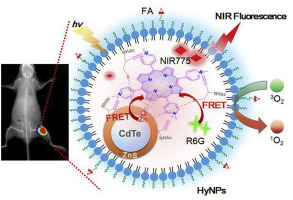当前位置:
X-MOL 学术
›
Biomaterials
›
论文详情
Our official English website, www.x-mol.net, welcomes your
feedback! (Note: you will need to create a separate account there.)
Rational engineering of semiconductor QDs enabling remarkable 1O2 production for tumor-targeted photodynamic therapy
Biomaterials ( IF 12.8 ) Pub Date : 2017-09-20 , DOI: 10.1016/j.biomaterials.2017.09.026 Yizhong Shen , Yidan Sun , Runqi Yan , Erquan Chen , Huan Wang , Deju Ye , Jing-Juan Xu , Hong-Yuan Chen
Biomaterials ( IF 12.8 ) Pub Date : 2017-09-20 , DOI: 10.1016/j.biomaterials.2017.09.026 Yizhong Shen , Yidan Sun , Runqi Yan , Erquan Chen , Huan Wang , Deju Ye , Jing-Juan Xu , Hong-Yuan Chen

|
Semiconductor quantum dots (QDs) have served as superior optically active nanomaterials for molecular imaging and photodynamic therapy (PDT), but the low singlet oxygen (1O2) quantum yield and lack of tumor selectivity have limited their applications for tumor PDT in vivo. Here, we report the rational engineering of QDs into tumor-targeting hybrid nanoparticles through micelle-encapsulating a pre-assembled unique QD-Zn-porphyrin complex, a highly fluorescent organic photosensitizer rhodamine 6G (R6G), and a near-infrared fluorophore NIR775 with folic acid labeled phospholipid polymers. These nanoparticles have large porphyrin payloads and strong light absorption capability, thus contributing to an extremely high 1O2 quantum yield (∼0.91) via an efficient dual energy transfer process. In vivo studies show that they can preferably accumulate in tumors through folate receptor-mediated active delivery, permitting non-invasive fluorescence imaging and effective PDT of tumors in living mice. This study highlights the utility of hybrid semiconductor QDs for both tumor imaging and PDT in vivo.
中文翻译:

合理设计半导体量子点,可实现显着的1 O 2产生,用于肿瘤靶向的光动力疗法
半导体量子点(QDs)已成为分子成像和光动力疗法(PDT)的优良光学活性纳米材料,但是单线态氧(1 O 2)的量子产率低和缺乏肿瘤选择性限制了它们在体内肿瘤PDT中的应用。在这里,我们报告通过胶束封装预先组装的独特QD-Zn-卟啉复合物,高荧光有机光敏剂若丹明6G(R6G)和具有叶酸标记的磷脂聚合物。这些纳米粒子具有大的卟啉有效负载和强大的光吸收能力,因此有助于产生极高的1 O 2。通过高效的双重能量转移过程获得的量子产率(约0.91)。体内研究表明,它们优选可通过叶酸受体介导的主动递送积聚在肿瘤中,从而允许在活体小鼠中进行无创荧光成像和有效的肿瘤PDT。这项研究强调了混合半导体QDs在体内肿瘤成像和PDT中的实用性。
更新日期:2017-09-20
中文翻译:

合理设计半导体量子点,可实现显着的1 O 2产生,用于肿瘤靶向的光动力疗法
半导体量子点(QDs)已成为分子成像和光动力疗法(PDT)的优良光学活性纳米材料,但是单线态氧(1 O 2)的量子产率低和缺乏肿瘤选择性限制了它们在体内肿瘤PDT中的应用。在这里,我们报告通过胶束封装预先组装的独特QD-Zn-卟啉复合物,高荧光有机光敏剂若丹明6G(R6G)和具有叶酸标记的磷脂聚合物。这些纳米粒子具有大的卟啉有效负载和强大的光吸收能力,因此有助于产生极高的1 O 2。通过高效的双重能量转移过程获得的量子产率(约0.91)。体内研究表明,它们优选可通过叶酸受体介导的主动递送积聚在肿瘤中,从而允许在活体小鼠中进行无创荧光成像和有效的肿瘤PDT。这项研究强调了混合半导体QDs在体内肿瘤成像和PDT中的实用性。











































 京公网安备 11010802027423号
京公网安备 11010802027423号